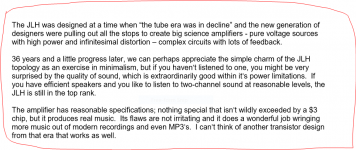My comments on JLH 1969 are based on a series of DBLTs. We liked it even though some of my panel picked it out as not 'accurate'.I see your comments as a slur - you are not saying you have you actually built any of these circuits or listened to them.
I gave the specifications for the circuit in question in post 9 you have given no technical argument to counter Linsley-Hood's results.
Have YOU built the circuit you posted in #18? If so, why don't you put some headphones (not your best ones) and a scope on it and see what happens when it overloads.
If you haven't, you can do this with less heartache in SPICE world.
I worshiped JLH for nearly a decade ... until I met him and realised he was a very persuasive writer but really just a tinkerer like many on this forum. He did do some good stuff, eg the JLH 1969 amp, and some really awful stuff too. I've built and owned some from both of these sets.
PS I rarely comment on 'sound' but if I do, it is almost certainly from doing DBLTs. Technical stuff ... usually only if I see some easy way to help a poster get better sound or learn something ... or if there is danger of the Holy Smoke escaping.
These days, I'm a beach bum so it matters little if you believe me or not. I'm sorry if you feel I have besmirched the name of your Lord JLH
PPS mjona, I see you HAVE built this headphone amp. Please be careful if you do this overload test. On 2nd thoughts, perhaps its not such a good idea after all. I'm sure it sounds wonderful.
Last edited by a moderator:
My comments on JLH 1969 are based on a series of DBLTs. We liked it even though some of my panel picked it out as not 'accurate'.
I have attached an extract from an article by Nelson Pass on his PLH design. Actually the split phase drive of the output transistors in the JLH is a strategy that had been used by D.T.N. Williamson in his post WW2 15W valve amplifier.
I built the 1969 JLH and in 1996 when a direct-coupled version with a proper regulated power supply appeared I built this version does a better job of controlling ripple than the voltage multiplier of the 1969 version which is one point of difference when approaching the power limits - the 1996 version also has more power.
I have a number of reference amplifiers to compare this with a Nait 5i, a Technics Class A A MOSFET 50W amplifier at home and another Technics amplifier at a beach property up the coast from where I live.
If I wanted to listen to Rock music at high volume I would use the Nait or one of the Technics amplifiers.
The 1996 will still go loud enough with reasonably efficient speakers (I have four monitor quality sets) but my hobby interest in DIY has led me to mini-monitor projects which are less efficient. Using the 1996 JLH it is easy to tell from the gradual change in sound quality when it is time to turn the volume down.
I have done circuit simulations but getting too involved in this reduces the time to for enjoying music and having two properties to maintain does take up time.
When talking about accuracy to music in my view this should be to acoustic sources rather than those electronically enhanced or synthesized. There is so much of this in your face TV repetitive advertising that as one gets older it is hard to relax to anything that is highly processed. Life is better to get away from city life and spend time at the beach where the pace of living is easier.
Attachments
- Status
- This old topic is closed. If you want to reopen this topic, contact a moderator using the "Report Post" button.
